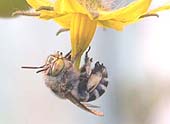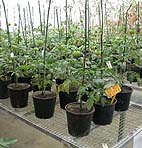Home
Aussie Bee Online
Welcome
New Articles
About Native Bees
Bee Photo Gallery
Bees in Your Area
Common Questions
Rescuing Native Bees
Exotic Bumblebees
What are Stingless Bees?
Buying Stingless Bees
Honey Production
Crop Pollination
Study Native Bees
Field Guide
Information Booklets
Tim Heard's Book
John Klumpp's Book
Aussie Bee Back Issues
Seminars
Links
Support Native Bees
Aussie Bee Shop
Order Form
Who We Are
Donations
Privacy Policy
Free Newsletter
Website Survey
Download Printer-Friendly PDF version of this article
Blue Banded Bee Pollination Trials
At Adelaide Uni
Dr Anne Dollin
Australian Native Bee Research Centre
September 2006
Dr Katja Hogendoorn and her team at the University of Adelaide have shown that blue banded bees could be a great alternative to European bumblebees for the Australian greenhouse tomato industry.
Building on research by Melissa Bell in 2002/2003 at the University of Western Sydney (see Aussie Bee Online Article 9), Katja Hogendoorn has lead a three year research program on breeding and using blue banded bees (Amegilla chlorocyanea) for greenhouse tomato pollination.
Growing Tomatoes Inside Greenhouses
Most tomatoes are grown outdoors in Australia. However, it is becoming increasingly popular to grow tomatoes inside enclosed greenhouses. Better quality tomatoes can be produced in greenhouses, using much less water and pesticides. The annual production of the Australian hydroponic tomato industry is currently worth about Aust$90 million.
One key drawback is that the flowers of tomato plants grown inside greenhouses must be manually pollinated. Tomato flowers need a special type of pollination called buzz pollination. The pollen of the tomato flower is trapped inside little capsules and the flower must be vibrated to release the pollen. Some bees can perform this trick by ‘buzzing’ the flower with their strong flight muscles. Commercial honeybees (Apis) cannot perform buzz pollination but other bees such as Australian blue banded bees and the European bumblebee are buzz pollination specialists.
There are no European bumblebees at present on the Australian mainland, so our greenhouse tomato growers must use an electric vibration wand tool to pollinate their tomato flowers. This manual pollination is expensive, costing about Aust$16,000 per hectare per year.
Bumblebees or Blue Banded Bees?
The introduction of European bumblebees to the Australian mainland is opposed by scientists concerned about the impact these exotic bees could have on our native fauna and flora. European bumblebees may also help spread exotic weeds in our farmland (more details). So Katja and her team have been researching the possible use of native blue banded bees as an alternative to European bumblebees for the greenhouse tomato industry.
In a three year research program, the team has developed protocols for breeding blue banded bees, year round, in large numbers and has developed nectar feeders and transportable nests for the bees. Furthermore, the team has demonstrated the excellence of Australian blue banded bees as pollinators of greenhouse tomatoes.
 |
The Blue Banded Bee Pollination Experiments
The researchers raised their experimental crops of tomatoes inside a 28m2 greenhouse compartment with glass windows. There were 12 - 20 actively foraging female blue banded bees in the compartment, with mud brick nest blocks and feeders containing a 50% solution of Apis honey.
Three different experiments were run with varying treatments given to each tomato flower:
|
Experiment 1
|
|
A single buzz from a blue banded bee
|
|
compared with
|
|
A single vibration treatment from an electric vibration wand
|
|
|
|
Experiment 2
|
|
One to two buzzes from blue banded bees
|
|
compared with
|
|
Three to six buzzes from blue banded bees
|
|
|
|
Experiment 3
|
|
Unlimited buzzes from blue banded bees
|
|
compared with
|
|
Wand pollination treatment
|
|
compared with
|
|
No pollination treatment
|
Pollination Results
Experiment 1: Flowers given a single buzz by a blue banded bee produced tomatoes that were 10.9% heavier than those vibrated with the electric wand. The blue banded bee pollinated tomatoes also had significantly more seeds than the wand pollinated tomatoes.
Experiment 2: Flowers given multiple buzzes by the blue banded bees produced tomatoes that were 11.2% heavier than those given only one or two buzzes.
Experiment 3: On average the flowers that were pollinated by the blue banded bees produced tomatoes that were 24% heavier than those pollinated with the electric wand. And the flowers that were wand pollinated produced tomatoes that were significantly heavier those that received no pollination.
As Good as Bumblebees
Overall, compared with the electric vibration wand method that is commonly used in Australian greenhouses today, these native blue banded bees were able to improve the tomato yield by 20 to 24%! This result is similar to the benefit of using European bumblebees to pollinate greenhouse tomatoes: reported increases in tomato yield with bumblebees in overseas studies range from 18.4% to 28.5%.
Blue banded bees are common Australian native bee species that are widespread on the Australian mainland. They are also potential buzz pollinators of eggplant and sweet pepper crops. Given the environmental risks that would come from importing European bumblebees to the Australian mainland, the further development of our native blue banded bees would be a highly worthwhile investment for the future of Australian agriculture!
 |
||
 |
||
|
Top: Tomato plants being grown for the pollination trials. Above: Mud brick nest blocks for the blue banded bees. Photos courtesy of Katja Hogendoorn.
|
K Hogendoorn, CL Gross, M Sedgley and MA Keller (2006) Increased tomato yield through pollination by native Australian Amegilla chlorocyanea (Hymenoptera: Anthophoridae). Journal of Economic Entomology 99(3), 828-833.
(If you have not used PDF before, click here.)
• For more interesting Aussie Bee Online articles on native bees, visit the contents
|
Please feel free to print out this article or to email copies of the PDF version to your friends. This article may also be reproduced or hosted on other websites providing it is kept in its full and unaltered form including ANBRC contact details.
|
.
Search Aussie Bee Website:
© 1997-2018 Australian Native Bee Research Centre
PO Box 74, North Richmond NSW 2754, Australia